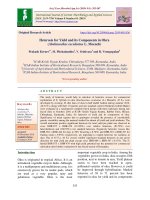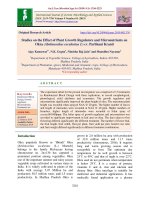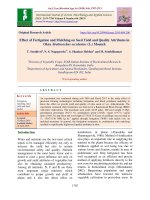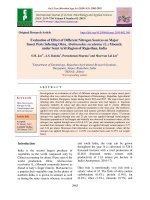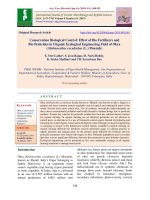Effect of different levels of NPK and FYM on physico-chemical properties of soil of okra [Abelmoschus esculentus L.] Var. Parbhani Kranti
Bạn đang xem bản rút gọn của tài liệu. Xem và tải ngay bản đầy đủ của tài liệu tại đây (311.15 KB, 10 trang )
Int.J.Curr.Microbiol.App.Sci (2020) 9(8): 603-612
International Journal of Current Microbiology and Applied Sciences
ISSN: 2319-7706 Volume 9 Number 8 (2020)
Journal homepage:
Original Research Article
/>
Effect of Different Levels of NPK and FYM on Physico-Chemical Properties
of Soil of Okra [Abelmoschus esculentus L.] Var. Parbhani Kranti
Radhakishan Yadav*, Tarence Thomas and Narendra Swaroop
Department of Soil Science and Agricultural Chemistry, [Naini Agricultural Institute],
Sam Higginbottom University of Agriculture, Technology and Sciences,
Prayagraj - 211007, U.P., India
*Corresponding author
ABSTRACT
Keywords
Okra, NPK and
FYM, Physicochemical Properties
of Soil etc
Article Info
Accepted:
10 July 2020
Available Online:
10 August 2020
The field experiment was conducted during kharif (rainy) season of 2019 on “Effect of
different levels of NPK and FYM on physico-chemical properties of soil of Okra (Abelmoschus
esculntus L.) var. Parbhani Karanti” on Central Research Farm Department of Soil Science and
Agricultural Chemistry, SHUATS, Prayagraj. The soil of experiment area falls in order
Inceptisol and soil texture was sandy loam (sand % 61.20, silt % 23.20 and clay % 14.6). There
were 9 treatments combination replicated thrice in 3 x 3 factorial randomized block design. It
was observed that for post harvest, soil properties in treatment T8- (100% RDF @ N100 P60 K50
kg ha-1 +100% FYM @ 25 t ha-1) were improved significantly due to organic and inorganic use
of inputs. The maximum values of pore space (60.1 %), water holding capacity (63.63 %),
organic carbon (0.62 %), available nitrogen (297.56 kg ha-1), available phosphorus (26.35 kg
ha-1) and available potassium (202.55 kg ha-1) was with treatment T8- (100% RDF @ N100 P60
K50 kg ha-1 +100% FYM @ 25 t ha-1). The combination of T8- (100% RDF @ N100 P60 K50 kg ha1
+100% FYM @ 25 t ha-1) showed slight decrease in pH (6.8), bulk density (1.18 Mg m -3) and
particle density (2.50 Mg m-3), the same treatment EC (0.33 dS m-1) was slightly increase in
post harvest soil. It may be concluded from trial that the various level of NPK and FYM used
from different sources in the experiment, the treatment T8 - (100% RDF @ N100 P60 K50 kg ha-1
+100% FYM @ 25 t ha-1) was found to be the best, for improvement in physical and chemical
properties of soil.
(Abelmoschus esculentus L.) originated in
Ethiopia (Sathish & Eswar, 2013). Okra
(Abelmoschus esculentus) is one of the most
widely known and utilized species of the
family Malvaceae (Naveed et al., 2009). Okra
is most popular in India, Nigeria, Sudan,
Pakistan, Ghana, Egypt, Benin, Saudi Arabia,
Mexico and Cameroon. Largest area and
production is in India followed by Nigeria.
Total area under okra in India is reported to
Introduction
Okra [Abelmoschus esculentus L.] is an
important fruit vegetable crop cultivated in
tropical, subtropical and mild temperate parts
of the world and belongs to the family
Malvaceae. In India, it is grown during
summer and rainy seasons for its tender pod,
which are cooked and consumed as a
vegetable (Chattopadhyay et al., 2011). Okra
603
Int.J.Curr.Microbiol.App.Sci (2020) 9(8): 603-612
be 528.37 thousand hectare, production
6145.97 thousand tonnes and productivity
11.5 t ha-1 in 2018-19. West Bengal is the
leading state of area and production of okra,
which has area 77.40 thousand hectare and
production 913.32 thousand tonnes. Highest
productivity is 17.40 t ha-1 of Andhra Pradesh.
Uttar Pradesh climate is good for okra that in
total area 22.64 thousand hectare and
production is 303.05 thousand tonnes in 201819 (NHB data base 2018-19).
inorganic fertilizers can improve crop
productivity (Mal et al., 2013). Organic
fertilizer released all type of micro and macro
nutrients that helps to plant elongation.
Organic fertilizers improved soil physical
properties and supplied of essential plant
nutrients for higher growth of plant, protect
soil against erosion, supply the cementing
substance for desirable aggregate soil
formation and loosen the soil. Application of
FYM sustains cropping system through better
nutrient recycling and provides all necessary
nutrients, thereby improving the physical and
biological properties of soil (Abou El-Magd
et al., 2006).
Total area under okra in World is reported to
be 2020528 hectare and production 9872826
tonnes in 2018. Okra is valued for its edible
green pods (fruits), a capsule that contains
many seeds. However, its leaves are also
eaten as a vegetable. Okra seeds are used as a
non-caffeinated substitute for coffee and also
as a source of seed oil (FAO, 2018). Okra is
said to be of economic importance because of
its nutritional value that has the potential to
improve food security (FAO, 2018). The
significance of crop further enhances due to
its multiple uses. The dry seed contains 13-22
percent good quality edible oil and 20-24 per
cent protein. The green fruits contain water
88.6 g, energy 36 kcal, protein 2.1 g,
carbohydrate 8.2 g, fat 0.2 g, fiber 1.7g, Ca 84
mg, P 90 mg, Fe 1.2 mg, beta carotene 185
micro gram, riboflavin 0.08 mg, thiamin 0.04
mg, niacin 0.6 mg and ascorbic acid 47 mg
per 100 g edible portion (Habtamu et al.,
2014). Fresh pods also contain about 30% of
recommended levels of vitamin C (16–29
mg), 10–20% of folate (46–88 mg) and about
5% of vitamin A (14–20 RAE) (Gemede et
al., 2014).
The effects of fertilizer on the growth and
yield of okra had been reported in various
studies (Agbede and AAdekiya, 2012), (Uka
et al., 2013). In the experiment conducted by
(Firoz et al., 2009) on the relative effects of
inorganic and organic fertilizer on the growth
of okra, it was observed that both fertilizer
types produced significantly higher value for
plant height, fresh weight, leaf area and dry
weight compared to the control without
fertilizer.
Nitrogen plays a major role among cultural
practices for increased crop production.
However, blanket application of inorganic
fertilizer to farmland soils without adequate
knowledge of the nutrient status, often leads
to increased soil acidity, particularly when
nitrogen fertilizers are applied (Akande et al.,
2010).
Phosphorus can influence fruiting and fruit
developments of crops and regarded as key of
life because it is directly involved in most
living process. Phosphorus is a key
constituent of ATP which transforms energy
to the plant. Phosphorus take part in various
physiological process and helps in nutrients
uptake by promoting root growth and their by
ensuring a good pod yield (Das et al., 2014).
The main challenge before India is to increase
the production of quality food in a sustainable
manner and feeding the country‟s large
population and increasing the income of the
farmer. The requirements of fertilizers in okra
are important for the early growth and total
production of fruit yield. Use of organic and
604
Int.J.Curr.Microbiol.App.Sci (2020) 9(8): 603-612
location reaches up to 460C – 480C and
seldom falls as low as 40C – 50C. The
relative humidity ranged between 20 to 94
percent. The average rainfall in this area is
around 1100 mm annually.
Potassium plays a unique role in osmotic
regulation, opening and closing of stomata
and improves the color, flavours and size of
fruits (Bhende et al., 2015).
Application of FYM and poultry manure or in
combination with chemical fertilizers
improved the soil organic C, total NPK status.
However, only organic manure or combined
applications of organic manure with inorganic
fertilizers increase soil microbial growth
(Kaur et al., 2005). The organic manure FYM
not only provides nutrient to the plant but also
improves the soil texture by binding effect of
soil aggregates. Organic manure increases
cation exchange capacity, water holding
capacity and phosphate availability of the soil
beside improving the fertilizer use efficiency
and microbial population of soil, it reduces
nitrogen loses due to slow release of nutrients
(Tadesse et al., 2013). FYM plus inorganic
NPK applications in irrigated systems resulted
in reduced bulk density, higher soil organic
carbon and hydraulic conductivity and
improved soil structure and microbial
communities (Bhattacharya et al., 2007).
The Experiment was laid out in a 3 x 3
Factorial Randomized Block Design (FRBD)
(Fisher R. A. 1958) with 9 treatments and 3
replications. The treatment consisted of all
combination, 3 levels of NPK fertilizer 0% @
N0 P0 K0 kg ha-1, 50% @ N50 P30 K25 kg ha-1
and 100% @ N100 P60 K50 kg ha-1 and 3 levels
of FYM 0%, 50% and 100% @ 0 t ha-1, 12.5 t
ha-1 and 25 t ha-1. The recommended dose of
fertilizers i.e. nitrogen, phosphrous and
potassium (100%)and FYM (100%) was
applied in the ratio of 100:60:50 kg ha-1 and
FYM 25 t ha-1, respectively. The source of
nitrogen was through urea (46% N),
phosphorus through single super phosphate
(16% P2O5), potassium through muriate of
potash (60% K2O) and FYM (0.5% N2, 0.2%
P2O5, and 0.5 % K2O). Dose of fertilizer was
applied in respective plots according to
treatment allocation uniform furrows opened
by about 5 cm. The plant distance R x R = 45
cm and P x P = 30 cm, and seed rate 8- 10 kg
ha-1. All the agronomic practices were carried
out uniformly to raise the crop.
Materials and Methods
The investigation on Effect of Different
Levels of NPK and FYM on Growth and
Yield of Okra [Abelmoschus esculentus L.]
var. Parbhani Karanti comprise of a field
experiment which was carried out at the Soil
Science Research Farm, Sam Higginbottom
University of Agriculture, Technology and
Science, Prayagraj during kharif season on
22th July to 18th October (2019-20).
Results and Discussion
Bulk density (Mg m-3)
The data presented in shows the Bulk density
(Mg m-3) of soil as influenced by N P K
fertilizers and FYM. The response Bulk
density (Mg m-3) of soil was found to be nonsignificant in levels of N P K and FYM. The
maximum Bulk density (Mg m-3) of soil was
recorded 1.31 Mg m-3 in treatment T0
(control) and minimum Bulk density (Mg m-3)
of soil was recorded 1.18 Mg m-3 in treatment
T8 (100% RDF @ N100 P60 K50 kg ha-1 +100%
FYM @ 25 t ha-1). Similar results were also
The area is situated on the South of Prayagraj
on the right side of the river Yamuna on the
South of Rewa Road at a distance of about 6
Km from Prayagraj city. It is situated at
25024‟23”N latitude, 81050‟38”E longitude
and at the altitude of 98 meter above the sea
level. The maximum temperature of the
605
Int.J.Curr.Microbiol.App.Sci (2020) 9(8): 603-612
reported by Yadav et al., (2019) and Ola et
al., (2017).
also reported by Salvi et al. (2015).
pH (1:2) W/V
-3
Particle density (Mg m )
The data presented in shows the pH of soil as
influenced by N P K fertilizers and FYM. The
response pH of soil was found to be
significant in levels of N P K and FYM. The
maximum pH of soil was recorded in
treatment 7.26 T0 (control) and minimum pH
of soil was recorded 6.88 in treatment T8
(100% RDF @ N100 P60 K50 kg ha-1 +100%
FYM @ 25 t ha-1).Similar results were also
reported by Bhambhu et al., (2016) and
Solangi et al., (2015).
The data presented in shows the particle
density (Mg m-3) of soil as influenced by N P
K fertilizers and FYM. The response particle
density (Mg m-3) of soil was found to be nonsignificant in levels of N P K and FYM. The
maximum particle density (Mg m-3) of soil
was recorded 2.62 Mg m-3 in treatment T0
(control) and minimum particle density (Mg
m-3) of soil was recorded 2.50 Mg m-3 in
treatment T8 (100% RDF @ N100 P60 K50 kg
ha-1 +100% FYM @ 25 t ha-1). Similar results
were also reported by Ola et al., (2017).
EC (dS m-1)
The data presented in shows the EC (dS m-1)
of soil as influenced by N P K fertilizers and
FYM. The response EC (dS m-1) of soil was
found to be significant in levels of N P K and
FYM. The maximum EC (dS m-1) of soil was
recorded 0.32 dS m-1 in treatment T8 (100%
RDF @ N100 P60 K50 kg ha-1 +100% FYM @
25 t ha-1) and minimum EC (dS m-1) of soil
was recorded 0.28 dSm-1 in treatment T0
(control). Similar results were also reported
by Salvi et al., (2015) and Ray et al., (2005).
% Pore space
The data presented in shows the % Pore space
of soil as influenced by N P K fertilizers and
FYM. The response % Pore space of soil was
found to be significant in levels of N P K and
FYM. The maximum % Pore space of soil
was recorded 60.1 % in treatment T0 (control)
and minimum % Pore space of soil was
recorded 47.15 % in treatment T8 (100% RDF
@ N100 P60 K50 kg ha-1 +100% FYM @ 25 t
ha-1). Similar results were also reported by
Lakra et al., (2017) and Salvi et al., (2015).
Organic carbon %
The data presented in shows the organic
carbon % in soil as influenced by N P K
fertilizers and FYM. The Organic carbon % in
soil increased significantly with the increase in
levels of N P K and FYM. The maximum
organic carbon % in soil was recorded 0.62 %
in treatment T8 (100% RDF @ N100 P60 K50 kg
ha-1 +100% FYM @ 25 t ha-1) which was
significantly higher than any other treatment
combination and the minimum organic carbon
% in soil was recorded 0.39 % in treatment T0
(control). Similar results were observed by
Salvi et al. (2015) and Lakra et al. (2017).
Water holding capacity %
The data presented in shows the water holding
capacity % of soil as influenced by N P K
fertilizers and FYM. The response water
holding capacity % of soil was found to be
significant in levels of N P K and FYM. The
maximum water holding capacity % of soil
was recorded 63.63 % in treatment T8 (100%
RDF @ N100 P60 K50 kg ha-1 +100% FYM @
25 t ha-1) and minimum water holding
capacity % of soil was recorded 45.53 % in
treatment T0 (control). Similar results were
606
Int.J.Curr.Microbiol.App.Sci (2020) 9(8): 603-612
Table.1 Treatment combination of different levels of N P K and FYM for okra trial
Treatment
Treatment combination
Symbol
T0
Control (Absolute control)
I0 + F0
0% RDF + 50% FYM @ 12.5 t ha
T1
0% RDF + 100% FYM @ 25 t ha
T2
-1
I0 + F1
-1
I0 + F2
-1
-1
50% RDF @ N50 P30 K25 kg ha + 0% FYM @ 0 t ha
T3
-1
I1 + F0
-1
T4
50% RDF @ N50 P30 K25 kg ha + 50% FYM @ 12.5 t ha
I1 + F1
T5
50% RDF @ N50 P30 K25 kg ha-1 + 100% FYM @ 25 t ha-1
I1+ F2
T6
100% RDF @ N100 P60 K50 kg ha-1 + 0% FYM @ 0 t ha-1
I2 + F0
T7
100% RDF @ N100 P60 K50 kg ha-1 + 50% FYM @ 12.5 t ha-1
I2 + F1
T8
100% RDF @ N100 P60 K50 kg ha-1 + 100% FYM @ 25 t ha-1
I2 + F2
Table.2 Physical analysis of soil before sowing of Okra (Abelmoschus esculentus L.)
Particulars
Results
Sand (%)
61.20
Silt (%)
23.20
Clay (%)
14.6
Textural class
Sandy loam
Bulk density (Mg m-3)
1.32
Particle density (Mg m-3)
2.61
Pore Space (%)
46.98
Soil Moisture (%)
21.05
Water Holding Capacity
47.12
Method employed
Bouyoucos Hydrometer method (1927)
Graduated Measuring Cylinder (Muthuval et al., 1992)
Table.3 Chemical analysis of soil before sowing of Okra (Abelmoschus esculentus L.)
Parameters
Method employed
results
Soil pH (1:2)
Digital pH meter (Jackson 1958)
7.3
Soil EC (dS m-1)
Digital conductivity meter (Wilcox 1950)
Organic Carbon (%)
Repid titration method (Walkley and Black, 1947)
0.27
0.42
Available Nitrogen (Kg ha-1)
Alkaline permanganate method (Subbaih and Asija, 1956)
276.43
Available Phosphorus (Kg ha-1)
Calorimetric Method (Olsen et al., 1954)
16.51
Available Potassium (Kg ha-1)
Flame photometric method (Toth and Price, 1949)
169.11
607
Int.J.Curr.Microbiol.App.Sci (2020) 9(8): 603-612
Table.4 Effect of different levels of NPK and FYM on Physical parameters of soil in Okra
Treatment
T0
T1
T2
T3
T4
T5
T6
T7
T8
F- test
S. Em+
C.D. at 5%
Bulk
density (Mg m-3)
1.31
1.29
1.28
1.27
1.25
1.24
1.26
1.20
1.18
NS
0.01
0.02
Particle
density (Mg m-3)
2.62
2.60
2.59
2.57
2.56
2.55
2.52
2.52
2.50
NS
0.00
0.01
Pore
space (%)
47.15
49.35
50.09
52.66
55.31
56.73
57.73
58.35
60.1
S
0.13
0.38
Water holding
capacity %
45.53
47.20
53.24
49.80
54.27
58.50
55.68
57.72
63.63
S
0.34
1.03
Table.5 Effect of different levels of NPK and FYM on Chemical parameters of soil in Okra
Treatment
pH (1:2)
w/v
EC (dS m-1)
T0
T1
T2
T3
T4
T5
T6
T7
T8
F – test
S. Em+
C.D. at 5%
7.26
7.23
7.09
7.07
7.01
7.00
6.98
6.97
6.88
S
0.01
0.02
0.28
0.29
0.30
0.30
0.31
0.31
0.32
0.32
0.33
S
0.13
0.40
Organic
carbon (%)
0.39
0.43
0.47
0.45
0.48
0.56
0.49
0.54
0.62
S
0.01
0.02
Nitrogen
(kg ha-1)
216.50
223.18
232.48
236.76
247.39
260.72
277.73
284.26
297.56
S
0.40
1.20
Phosphorus
(kg ha-1)
14.69
15.41
16.67
15.76
17.31
21.83
19.68
23.37
26.35
S
0.31
0.93
Potassium
(kg ha-1)
131.14
151.99
173.20
154.29
171.84
186.31
163.51
182.38
202.55
S
0.35
1.06
Fig.1 Effect of different levels of NPK and FYM on Physical parameters of soil in Okra
608
Int.J.Curr.Microbiol.App.Sci (2020) 9(8): 603-612
Fig.2 Effect of different levels of NPK and FYM on Chemical parameters of soil in Okra
Fig.3 Effect of different levels of NPK and FYM on chemical parameters of soil in Okra
Available Nitrogen (Kg ha-1)
Available Phosphorus (Kg ha-1)
The data presented in shows the available
nitrogen in soil as influenced by N P K
fertilizers and FYM. The available nitrogen in
soil increased significantly with the increase
in levels of N P K and FYM. The maximum
available nitrogen in soil was recorded 297.56
(Kg ha-1) in treatment T8 (100% RDF @ N100
P60 K50 kg ha-1 +100% FYM @ 25 t ha-1)
which was significantly higher than any other
treatment combination and the minimum
available nitrogen in soil was recorded 216.50
(Kg ha-1) in treatment T0 (control). Similar
results were observed by Bhambhu et al.
(2016).
The data presented in shows the available
phosphorus in soil as influenced by N P K
fertilizers and FYM. The available
phosphorus in soil increased significantly
with the increase in levels of N P K and FYM.
The maximum available phosphorus in soil
was recorded 26.35 (Kg ha-1) in treatment T8
(100% RDF @ N100 P60 K50 kg ha-1 +100%
FYM @ 25 t ha-1) which was significantly
higher than any other treatment combination
and the minimum available phosphorus in soil
was recorded 14.69 (Kg ha-1) in treatment T0
(control). Similar results were observed by
Yadav et al. (2019).
609
Int.J.Curr.Microbiol.App.Sci (2020) 9(8): 603-612
Available Potassium (Kg ha-1)
science and agricultural chemistry, sam
higginbottom university of agriculture,
technology and sciences, Prayagraj, Uttar
Pradesh.
The data presented in shows the available
potassium in soil as influenced by N P K
fertilizers and FYM. The maximum available
potassium in soil was recorded 202.55 (Kg ha1
) in treatment T8 (100% RDF @ N100 P60 K50
kg ha-1 +100% FYM @ 25 t ha-1) which was
significantly higher than any other treatment
combination and the minimum available
potassium in soil was recorded 131.14 (Kg ha1
) in treatment T0 (control). Similar results
were observed by Bhambhu et al. (2016).
References
Abou El-Magd, M. M., El-Bassiony, A. M.
and Fawzy, Z. F. (2006) Effect of
organic manure with or without
chemical fertilizers on growth, yield
and quality of some varieties of
broccoli plants. Journal of Applied
Sciences Research. 2: 791-798.
Agbede, T. M. and Adekiya, A. O. (2012)
Effect of wood ash, poultry manure and
NPK fertilizer on soil and leaf nutrient
composition, growth and yield of okra
(Abelmoschus esculentus). Emir. J.
Food Agric. 2012. 24 (4): 314-321.
Akande, M. O., Oluwatoyinbo, F. I.,
Adediran, J. A., Buari, K. W. and
Yusuf, I. O. (2003) Soil amendments
affect the release of P from rock
phosphate and the development and
yield of okra. J of Veg. Crop
Production,9(2):3–9.
Bhambhu, Ram, Krishan., Thomas, Tarence
and Rao P. Smriti (2016) Effect of
NPK and Neem Cake on PhysicoChemical Properties of Soil, Growth
and Yield of Hybrid maize (Zea mays
L.). Advances in Life Sciences 5(16).
Bhattacharyya, R., Chandra, S., Singh, R.,
Kundu, S., Srivastva, A. and Gupta, H.
(2007) Long-term farm yard manure
application effects on properties of a
silty clay loam soil under irrigated
wheat-soybean rotation. Soil Till. Res.
94, 386–396.
Bhende, S. K., Deshmukh, H. K., Nimbolkar,
P.K., Dewangan, R. K. and Nagone, A.
H. (2015) Effact of phosphorus and
potassium on quality attributes of okra
cv. „Arka Anamik‟. Int. J. Environ Sci.
6(2) 225-231.
It was concluded from trial that the different
levels of N P K and FYM used for okra, the
treatment combination T8 – [100% N P K @
N100P60K50 kg ha-1 + 100% FYM @ 25 t ha-1]
was found to be the best treatment physicochemical properties of soil. The slight
decrease in soil pH 6.8, bulk density 1.18 Mg
m-3 and particle density 2.50 Mg m-3 has
resulted due to the application of T8 @100%
RDF @ N100 P60 K50 kg ha-1 + @100% FYM
@ 25 t ha-1). While maximum pore space 60.1
%, water holding capacity 63.63%, organic
carbon 0.62 %, available nitrogen 297.56 kg
ha-1, available phosphorus 26.35 kg ha-1 and
available potassium 202.55 kg ha-1, found
with application of T8 @100% RDF @ N100
P60 K50 kg ha-1 + @100% FYM @ 25 t ha-1). It
was also revealed that the application of NPK
with FYM were excellent source for
fertilization than fertilizers alone. It can be
concluded that combined application of FYM
and inorganic NPK fertilizers improved the
physico-chemical properties of soil.
Acknowledgements
I am grateful for ever-inspiring guidance,
constant encouragement, keen interest and
scholarly comments
and constructive
suggestions throughout the course of my
studies and investigation, from, head of the
department and staff, department of soil
610
Int.J.Curr.Microbiol.App.Sci (2020) 9(8): 603-612
Bouyoucous, G. J. (1927) The hydrometer as
a new method for the mechanical
analysis of soils.Soil Sci., 23: 393-395.
Chattopadhyay, A., Dutta, S. and Chatterjee,
S. (2011) Seed yield and quality of
okra as influenced by sowing dates.
African Journal of Biotechnology
10(28): 54615467.
Das, A. K., Prasad, B. and Singh, R. (2014)
Response of chemical fertilizer and
vermicompost on okra (Abelmoschus
esculentus L.) cv. Prabhani kranti. The
Asian J. of Horti. 9(2):372- 376.
FAO. (2018) The state of food and agriculture
(Food and Agriculture Organization of
the United Nations. 2018).
Firoz, Z. A. (2009) Impact of nitrogen and
phosphorus on the growth and yield of
okra [Abelmoschus esculentus (L.)
Moench] in hill slope condition.
Bangladesh J. Agril. Res. 34(4): 713722, December 2009.
Gemede, H.F., Ratta, N., Haki, G.D.,
Woldegiorgis, A.Z., Beyene, F., (2014)
Nutritional quality and health benefits
of okra (Abelmoschus esculentus): a
review. Food Sci. Qual. Manage. 33,
87–96.
Habtamu, F. G., Negussie, R., Gulelat, D.H.,
Ashagrie, Z. W. and Fekadu, B. (2014)
Nutritional quality and health benefits
of okra (Abelmoschus esculentus).
Food
Science
and
Quality
Management, 33: ISSN 2224-6088.
Jackson, M. L. (1958) Soil chemical analysis,
Second edition Indian Reprint, prentice
hall of India, New Delhi. PP 498.
Kaur, K., Kapoor, K. K. and Gupta, A. P.
(2005) Impact of organic manure with
and without mineral fertilizers on soil
chemical and biological properties
under tropical conditions. Journal
Nutri. Soil Sci, 168:117-122.
Lakra, Reena., Swaroop, Narendra and
Thomas, Tarence (2017) Effect of
Different Levels of NPK and
Vermicompost on Physico-Chemical
Properties of Soil, Growth and Yield of
Okra [Abelmoschus esculentus L.] var.
Rohini. International Journal of
Current Microbiology and Applied
Sciences. (2017) 6(7): 1398-1406.
Mal, B., Mahapatra, P., Mohanty S. and
Mishra H. N. (2013) Growth and yield
parameters of okra (Abelmoschus
esculentus) influenced by Diazotrophs
and chemical fertilizers. Journal of
Crop and Weed, 9(2):109-112(2013).
Muthuval, P., Udayasoorian, C., Nateson, R.
and
Ramaswami,
P.P.
(1992)
Elucidated the Laboratory manual on
soil analysis for physical and chemical
characteristic of soil, Introduction to
soil analysis. Laser typesetting and offset printing by scroll DP, 68, D. B.
Road, R. S. Puram, Coimbatore 641002.
Naveed, A., Khan, A.A., & Khan, I.A, (2009).
Generation mean analysis of water
stress tolerance in okra (Abelmoschus
esculentus L.). Pak. J. Bot., 41: 195205.
NHB. (2018- 19) National Horticulture
Database
–
2017-18.
National
Horticulture Board Government of
India, Gurgaon, India. www.nhb.gov.in.
Ola, Rajendra., David, A. Alfred., Thomas,
Tarence., Baloda, Satyapal Singh., and
Singh, Prabhoo (2017) Response of
Different Levels of N P K and FYM on
Soil Health and Yield of Okra
(Abelmoschus Esculentus L.) Var. Arka
Anamika. Chem Sci Rev Lett 2017,
6(22), 827-831.
Olsen, S. R., Cole, C. V., Watnahe, F. S. and
Dean, L. A. (1954) Estimation of
available phosphorus in soils by
extraction with sodium bicarbonate
U.S. Deptt. Agr.Circ. pp 939.
Ray, R., Patra, S.K., Ghosh, K. K. and Sahoo,
S.K. (2005) Integrated Nutrient
Management in okra [Abelmoschus
611
Int.J.Curr.Microbiol.App.Sci (2020) 9(8): 603-612
esculentus (L.) Moench] in a River
Basin. Indian Journal of Horticulture.
62(3): 260-264.
Salvi, V. G., Shinde, Minal, Bhure, S. S. and
Khanvilkar, M. H. (2015) Effect of
integrated nutrient management on soil
fertility and yield of okra in coastal
region of Maharashtra. Asian J. Soil
Sci., (Dec., 2015) 10 (2): 201-209.
Sathish, D., and Eswar, A. (2013). A Review
on: Abelmoschus esculentus (Okra).
Int. Res J Pharm. App Sci., 2013;
3(4):129-132.
Solangi, Majeeduddin., Tagar, Ahmed, Ali.,
Solangi, Abdul, Malik., Siyal, Abdul,
Ghafoor., Soothar, Rajesh, Kumar and
Shah, Ali, Raza. (2015) Nutrient
uptake of some Okra varieties as
influenced by different levels of
applied N, P and K. Sci. Int. (Lahore),
27(5), 4327-4331.
Subbiah, B. V. and Asija, G. L. (1956) a rapid
procedure for the estimate of Available
nitrogen
in
soil
current
sciences.25:259-260.
Tadesse, T., Dechassa. N., Bayu, W. and
Gebeyehu, S. (2013) Effects of
Farmyard Manure and Inorganic
Fertilizer Application on Soil PhysicoChemical Properties and Nutrient
Balance in Rain-Fed Lowland Rice
Ecosystem. American Journal of Plant
Sciences, 4: 309-316.
Toth, S. J. and Prince, A. L. (1949).
Estimation of Cation Exchange
Capacity and exchangeable Ca, K,
and Na content of soil by flame
photometer technique. Soil Sci. 67:
439-445.
Uka, U. N., Chukwuka, K. S. and Iwuagwu,
M. (2013) Relative Effect of Organic
and Inorganic Fertilizers on the Growth
of Okra [Abelmoschus esculentus (l.)
moench]. Journal of Agricultural
Sciences Vol. 58, No. 3, 2013 Pages
159-166.
Walkley, A. and Black, I. A. (1947) Critical
examination of rapid method for
determining organic carbon in soils,
effect of variance in digestion
conditions and of inorganic soil
constituents. Soil sci. pp. 632:251.
Wilcox, L. V. (1950) Electrical conductivity,
Amer Water works Assoc. J. 42: pp
775-776.
Yadav, Sanwar Mal., Yadav, Lekhraj., Rao,
P. Smrit and Thomas, Tarence (2019)
Effect of different levels of NPK and
Vermicompost on Physico-Chemical
properties of Soil of okra (Abelmoschus
esculentus L.) Var. Kashi Kranti.
International Journal of Chemical
Studies 2019; 7(5): 31-34.
How to cite this article:
Radhakishan Yadav, Tarence Thomas and Narendra Swaroop. 2020. Effect of Different Levels
of NPK and FYM on Physico-Chemical Properties of Soil of Okra [Abelmoschus esculentus L.]
Var. Parbhani Kranti. Int.J.Curr.Microbiol.App.Sci. 9(08): 603-612.
doi: />
612
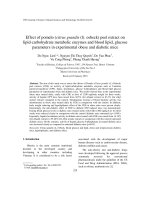


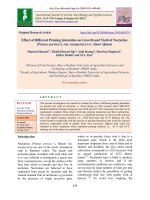
![Effect of precision farming techniques involving fertigation and mulching on growth attributes and seed yield of okra var. Arka Anamika [Abelmoschus esculentus (L.) Moench]](https://media.store123doc.com/images/document/2020_01/14/medium_ynr1578936108.jpg)
